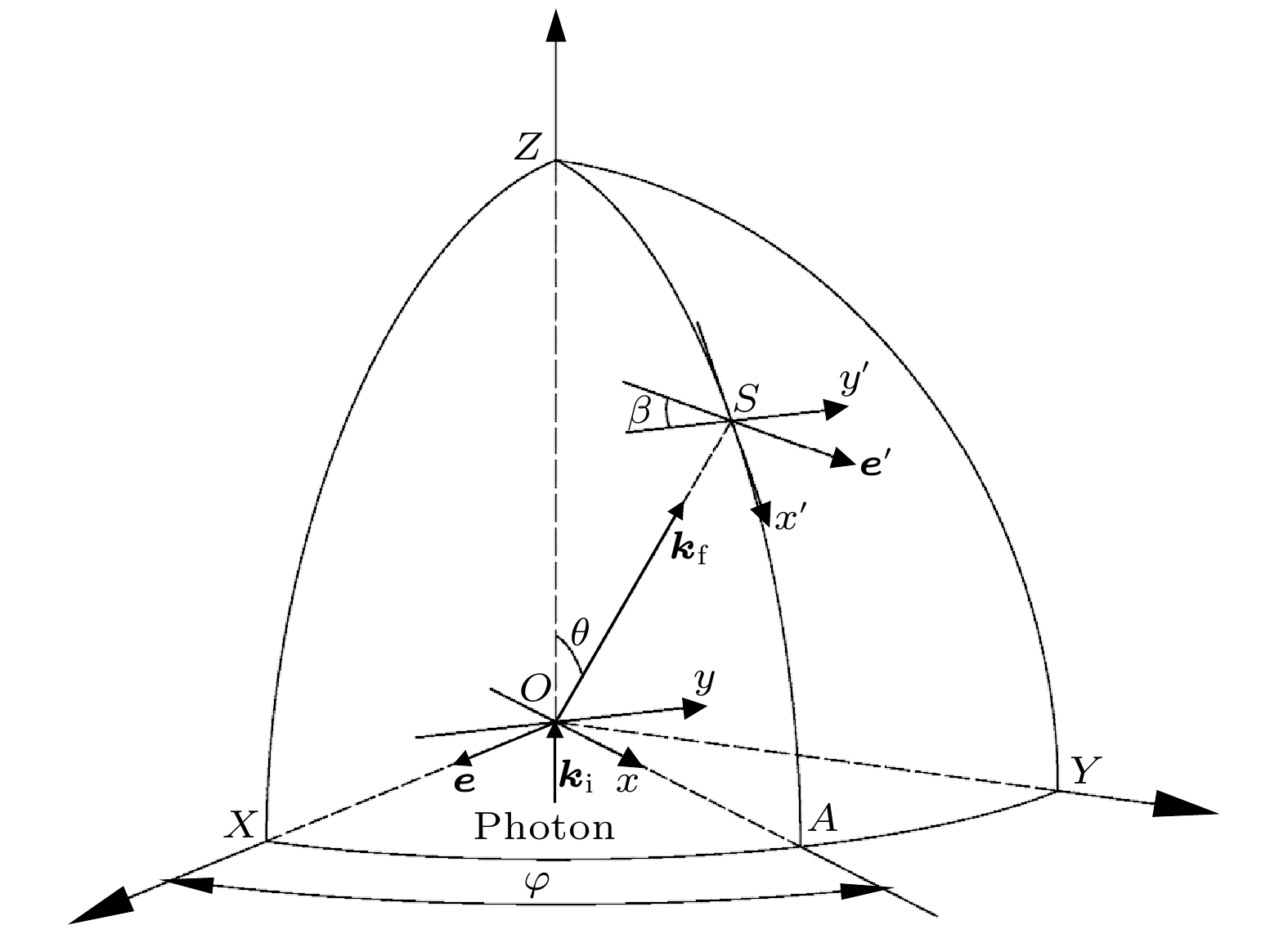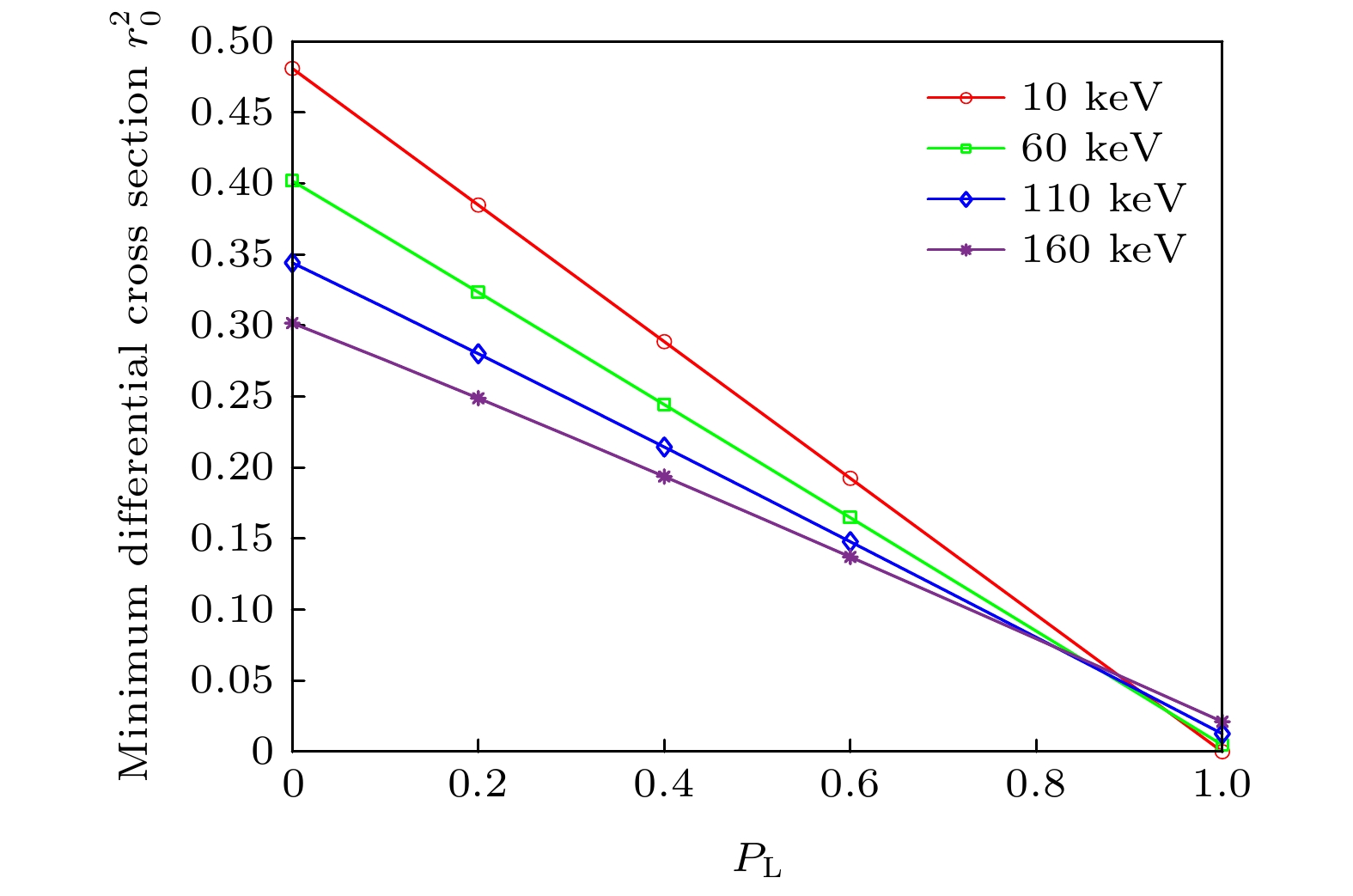-
X-ray fluorescence computed tomography (XFCT) is a molecular imaging technique with great potential applications in biomedical imaging, in which used is the primary X-ray to excite element probes with high atomic number inside samples or tissues for functional imaging. However, owing to the limitation of molecular sensitivity and spatial resolution, the XFCT has not been widely used in the molecular imaging. A large number of Compton scattering photons are produced as the broadband primary X-ray passes through the samples or tissues, forming a strong noise background in the collected XRF signal, which is a major cause of limited molecular sensitivity. Therefore, eliminating the Compton scattering noise is very important for improving molecular sensitivity. In this paper, we summarize the main physical processes involved in the imaging process of XFCT, including the angle distribution and polarization state of the fluorescence and Compton scattering photons, fluorescence yield and deexcitation time of K-shell vacancy. The above physical processes are the main limitations of the imaging quality of XFCT. Through the derivation and analysis of physical processes, we explore the possibility of using these physical effects to reduce the Compton scattering noise and draw some conclusions below. 1) The deexcitation time of K-shell vacancy of the element with high atomic number is very short, consequently the scattered light and fluorescence cannot be distinguished between each other under the time resolution condition of the existing detector. 2) The angular distribution of the K-shell fluorescence emission is isotropic, and the differential cross section of Compton scattering reaches a minimum value near the polarization direction of the incident light of which the minimum decreases as the linear polarization degree of the incident light increases. Therefore, the polarized light source is beneficial to reducing the Compton scattering noise. 3) The linear degree of polarization of K-shell fluorescence is zero, while the Compton scattering photons possess a certain linear degree of polarization in some scattering directions, so the difference between polarization states may be helpful in reducing the Compton scattering noise.
-
Keywords:
- X-ray fluorescence /
- computed tomography /
- polarized X-rays /
- Compton scattering /
- functional imaging
[1] Boisseau P, Grodzins L 1987 Hyperfine Interact. 33 283
 Google Scholar
Google Scholar
[2] Cheong S K, Jones B L, Siddiqi A K, Liu F, Manohar N, Cho S H 2010 Phys. Med. Biol. 55 647
 Google Scholar
Google Scholar
[3] Bazalova M, Kuang Y, Pratx G, Xing L 2012 IEEE Trans. Med. Imaging 31 1620
 Google Scholar
Google Scholar
[4] Sjölin M, Danielsson M 2014 Phys. Med. Biol. 59 6507
 Google Scholar
Google Scholar
[5] Li L, Zhang S Y, Li R Z, Chen Z Q 2017 Opt. Eng. 56 043106
 Google Scholar
Google Scholar
[6] Zhang S Y, Li L, Chen Z Q 2019 IEEE Access 7 113589
 Google Scholar
Google Scholar
[7] Li L, Li R Z, Zhang S Y, Chen Z Q 2016 Proc. of SPIE 9967 99670F
 Google Scholar
Google Scholar
[8] Zhang S Y, Li L, Chen J Y, Chen Z Q, Zhang W L, Lu H B 2019 Int. J. Mol. Sci. 20 2315
 Google Scholar
Google Scholar
[9] Ahmad M, Bazalova M, Xiang L, Xing L 2014 IEEE Trans. Med. Imaging 33 1119
 Google Scholar
Google Scholar
[10] Sasaya T, Sunaguchi N, Hyodo K, Zeniya T, Takeda T, Yuasa T 2017 Sci. c Rep. 7 44143
 Google Scholar
Google Scholar
[11] Chi Z, Du Y, Huang W, Tang C 2020 J. Synchrotron Radiat. 27 737
 Google Scholar
Google Scholar
[12] Vernekohl D, Tzoumas S, Zhao W, Xing L 2018 Med. Phys. 45 3741
 Google Scholar
Google Scholar
[13] Mcmaster W H 1961 Rev. Mod. Phys. 33 8
 Google Scholar
Google Scholar
[14] Jones J A, D’Addario A J, Rojec B L, Milione G, Galvez E J 2016 Am. J. Phys. 84 822
 Google Scholar
Google Scholar
[15] Bambynek W, Crasemann B, Fink R W, Freund H U, Mark H, Swift C D, Price R E, Rao P V 1972 Rev. Mod. Phys. 44 716
 Google Scholar
Google Scholar
[16] Hubbell JH, Trehan PN, Singh N, Chand B, Mehta D, Garg ML, Garg RR, Singh S, Puri S 1994 J. Phys. Chem. Ref. Data 23 339
 Google Scholar
Google Scholar
[17] Ertuğral B, Apaydın G, Çevik U, Ertuğrul M, Kobya A İ 2007 Radiat. Phys. Chem. 76 15
 Google Scholar
Google Scholar
[18] Scofield J H 1974 Phys. Rev. A 9 1041
 Google Scholar
Google Scholar
[19] Schaart D R 2021 Phys. Med. Biol. 66 09TR01
 Google Scholar
Google Scholar
[20] Han I, Şahin M, Demir L 2008 Can. J. Phys 86 361
 Google Scholar
Google Scholar
[21] E G Berezhko, N M Kabachnik 1977 J. Phys. B:At. Mol. Phys. 10 2467
 Google Scholar
Google Scholar
[22] Kämpfer T, Uschmann I, Wu Z W, Surzhykov A, Fritzsche S, Förster E, Paulus G G 2016 Phys. Rev. A 93 033409
 Google Scholar
Google Scholar
[23] 柳钰, 徐忠锋, 王兴, 曾利霞, 刘婷 2020 69 043201
 Google Scholar
Google Scholar
Liu Y, Xu Z F, Wang X, Zeng L X, Liu T 2020 Acta Phys. Sin. 69 043201
 Google Scholar
Google Scholar
[24] Kahlon K S, Aulakh H S, Singh N, Mittal R, Allawadhi K L, Sood B S 1991 Phy. Rev. A 43 1455
 Google Scholar
Google Scholar
[25] Depaola G O 2003 Nucl. Instrum. Methods Phys. Res., Sect. A 512 619
 Google Scholar
Google Scholar
[26] Matt G, Feroci M, Rapisarda M, Costa E 1996 Radiat. Phys. Chem. 48 403
 Google Scholar
Google Scholar
[27] Fano U 1949 JOSA 39 859
 Google Scholar
Google Scholar
[28] Hamzawy A 2016 Radiat. Phys. Chem. 119 103
 Google Scholar
Google Scholar
[29] Hubbell J H 1997 Radiat. Phys. Chem. 50 113
 Google Scholar
Google Scholar
[30] Hubbell J H, Veigele W J, Briggs E A, Brown R T, Cromer D T, Howerton D R 1975 J. Phys. Chem. Ref. Data 4 471
 Google Scholar
Google Scholar
[31] Hubbell J H, O/verbo/ I 1979 J. Phys. Chem. Ref. Data 8 69
 Google Scholar
Google Scholar
[32] Chantler C T 1995 J. Phys. Chem. Ref. Data 24 71
 Google Scholar
Google Scholar
[33] Tartari A, Taibi A, Bonifazzi C, Baraldi C 2002 Phys. Med. Biol. 47 163
 Google Scholar
Google Scholar
[34] Zhang L, YangDai T Y 2016 Appl. Radiat. Isot. 114 179
 Google Scholar
Google Scholar
-
图 5
$\varphi = 0{\rm{ , \pi }}$ 处微分截面随散射角变化 (a)${P_{\rm{L}}} = 1$ 时相干、非相干和总微分截面; (b) 不同线偏振度时的总微分截面; (c)${P_{\rm{L}}} = $ $ {\rm{0}}{\rm{.5}}$ 时不同入射能量下的总微分截面Figure 5. Differential cross section varying with
$\theta $ at$\varphi = 0{\rm{ , \pi }}$ : (a) Incoherent, coherent and total differential cross section at${P_{\rm{L}}} = 1$ ; (b) total differential cross section varying with$\theta $ for different${P_{\rm{L}}}$ ; (c) total differential cross section varying with$\theta $ for different incident energy at${P_{\rm{L}}} = {\rm{0}}{\rm{.5 }}$ 图 7 不同能量下
$\theta = {\rm{π}}/2{\rm{ , }}\varphi = 0,\;{\rm{\;\pi }}$ 处散射光线偏振度随入射光线偏振度变化Figure 7. The linear polarization of scattering photons
$ P_{\rm{L}}^{({\rm{f}})} $ varying with$ P_{\rm{L}}^{({\rm{i}})} $ at$\theta = {\rm{π}}/2{\rm{ , }}~\varphi = 0,\;{\rm{ \pi }}$ for different incident energy. -
[1] Boisseau P, Grodzins L 1987 Hyperfine Interact. 33 283
 Google Scholar
Google Scholar
[2] Cheong S K, Jones B L, Siddiqi A K, Liu F, Manohar N, Cho S H 2010 Phys. Med. Biol. 55 647
 Google Scholar
Google Scholar
[3] Bazalova M, Kuang Y, Pratx G, Xing L 2012 IEEE Trans. Med. Imaging 31 1620
 Google Scholar
Google Scholar
[4] Sjölin M, Danielsson M 2014 Phys. Med. Biol. 59 6507
 Google Scholar
Google Scholar
[5] Li L, Zhang S Y, Li R Z, Chen Z Q 2017 Opt. Eng. 56 043106
 Google Scholar
Google Scholar
[6] Zhang S Y, Li L, Chen Z Q 2019 IEEE Access 7 113589
 Google Scholar
Google Scholar
[7] Li L, Li R Z, Zhang S Y, Chen Z Q 2016 Proc. of SPIE 9967 99670F
 Google Scholar
Google Scholar
[8] Zhang S Y, Li L, Chen J Y, Chen Z Q, Zhang W L, Lu H B 2019 Int. J. Mol. Sci. 20 2315
 Google Scholar
Google Scholar
[9] Ahmad M, Bazalova M, Xiang L, Xing L 2014 IEEE Trans. Med. Imaging 33 1119
 Google Scholar
Google Scholar
[10] Sasaya T, Sunaguchi N, Hyodo K, Zeniya T, Takeda T, Yuasa T 2017 Sci. c Rep. 7 44143
 Google Scholar
Google Scholar
[11] Chi Z, Du Y, Huang W, Tang C 2020 J. Synchrotron Radiat. 27 737
 Google Scholar
Google Scholar
[12] Vernekohl D, Tzoumas S, Zhao W, Xing L 2018 Med. Phys. 45 3741
 Google Scholar
Google Scholar
[13] Mcmaster W H 1961 Rev. Mod. Phys. 33 8
 Google Scholar
Google Scholar
[14] Jones J A, D’Addario A J, Rojec B L, Milione G, Galvez E J 2016 Am. J. Phys. 84 822
 Google Scholar
Google Scholar
[15] Bambynek W, Crasemann B, Fink R W, Freund H U, Mark H, Swift C D, Price R E, Rao P V 1972 Rev. Mod. Phys. 44 716
 Google Scholar
Google Scholar
[16] Hubbell JH, Trehan PN, Singh N, Chand B, Mehta D, Garg ML, Garg RR, Singh S, Puri S 1994 J. Phys. Chem. Ref. Data 23 339
 Google Scholar
Google Scholar
[17] Ertuğral B, Apaydın G, Çevik U, Ertuğrul M, Kobya A İ 2007 Radiat. Phys. Chem. 76 15
 Google Scholar
Google Scholar
[18] Scofield J H 1974 Phys. Rev. A 9 1041
 Google Scholar
Google Scholar
[19] Schaart D R 2021 Phys. Med. Biol. 66 09TR01
 Google Scholar
Google Scholar
[20] Han I, Şahin M, Demir L 2008 Can. J. Phys 86 361
 Google Scholar
Google Scholar
[21] E G Berezhko, N M Kabachnik 1977 J. Phys. B:At. Mol. Phys. 10 2467
 Google Scholar
Google Scholar
[22] Kämpfer T, Uschmann I, Wu Z W, Surzhykov A, Fritzsche S, Förster E, Paulus G G 2016 Phys. Rev. A 93 033409
 Google Scholar
Google Scholar
[23] 柳钰, 徐忠锋, 王兴, 曾利霞, 刘婷 2020 69 043201
 Google Scholar
Google Scholar
Liu Y, Xu Z F, Wang X, Zeng L X, Liu T 2020 Acta Phys. Sin. 69 043201
 Google Scholar
Google Scholar
[24] Kahlon K S, Aulakh H S, Singh N, Mittal R, Allawadhi K L, Sood B S 1991 Phy. Rev. A 43 1455
 Google Scholar
Google Scholar
[25] Depaola G O 2003 Nucl. Instrum. Methods Phys. Res., Sect. A 512 619
 Google Scholar
Google Scholar
[26] Matt G, Feroci M, Rapisarda M, Costa E 1996 Radiat. Phys. Chem. 48 403
 Google Scholar
Google Scholar
[27] Fano U 1949 JOSA 39 859
 Google Scholar
Google Scholar
[28] Hamzawy A 2016 Radiat. Phys. Chem. 119 103
 Google Scholar
Google Scholar
[29] Hubbell J H 1997 Radiat. Phys. Chem. 50 113
 Google Scholar
Google Scholar
[30] Hubbell J H, Veigele W J, Briggs E A, Brown R T, Cromer D T, Howerton D R 1975 J. Phys. Chem. Ref. Data 4 471
 Google Scholar
Google Scholar
[31] Hubbell J H, O/verbo/ I 1979 J. Phys. Chem. Ref. Data 8 69
 Google Scholar
Google Scholar
[32] Chantler C T 1995 J. Phys. Chem. Ref. Data 24 71
 Google Scholar
Google Scholar
[33] Tartari A, Taibi A, Bonifazzi C, Baraldi C 2002 Phys. Med. Biol. 47 163
 Google Scholar
Google Scholar
[34] Zhang L, YangDai T Y 2016 Appl. Radiat. Isot. 114 179
 Google Scholar
Google Scholar
Catalog
Metrics
- Abstract views: 6254
- PDF Downloads: 96
- Cited By: 0















 DownLoad:
DownLoad:




























